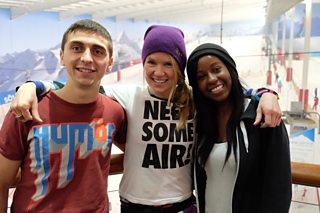The making of...Me & My New Brain
By Director Graeme McAulay

Just because someone looks fine, you should never take for granted all the hard work their brain is doing behind the scenes
When I first met snowboard instructor Charlie Elmore in July 2014, I was worried I’d made a huge mistake.
I’d agreed to make a documentary about Traumatic Brain Injury (TBI) and she was to be the star. I’d read that head injuries were the single biggest cause of disability in young people in the UK and I knew that Charlie had sustained a serious brain injury in a snowboarding accident a few years ago. I’d also been told that brain injuries often left people seriously debilitated, having to re-learn basic stuff like walking and talking. The trouble was, there didn’t seem to be anything wrong with Charlie at all.
Just a few years earlier, Charlie was lying unconscious in the snow after an accident on a snowboard jump left her fighting for life. She was helicoptered to an Austrian hospital where she was put into a coma to try to save her bleeding, swelling brain. Doctors didn’t know whether she would ever wake up and - if she did - whether her brain injury would leave her severely disabled.
Charlie did wake up and she went on to make an amazing physical recovery. Despite the considerable damage done to her brain, over the coming months an incredible transformation occurred inside her skull - her brain literally re-wired itself. It formed new pathways around her damaged brain cells and, through intensive hospital rehab, Charlie quickly got back on her feet. Her determination was so great that, in less than a year, she was back on a snowboard in the Swiss Alps.
But although Charlie’s recovery seemed complete, it wasn’t. Doctors sometimes refer to brain injury as a ‘hidden disability’ because the long-term mental effects can be difficult to see. By the time I met Charlie, they were almost impossible to spot. But as I followed her with a camera over the coming months, I gradually began to understand the huge impact the injury has had on her life. As Charlie re-traced the steps of her recovery, it became clear just how much we all take our mental powers for granted.
Everyday things like maintaining friendships, having a successful career or even just going to the pub involve extremely complex brain-work. A brain injury makes it all much, much harder to cope with. The problem is, people can’t see anything wrong, so they often just don’t realise. The effects can even be hidden from the patients themselves. We are all changing every day and all affected by the experiences we have as we go through life - so how does someone with a Brain Injury work out how different the person they are now is to the person they might have been if they hadn’t had their accident?
One of the things that has helped Charlie make sense of the changes that have gone on inside her brain is sharing her experiences with other people who have had similar injuries. She introduced me to her friends Tai and Callum and we also met Hannah – a young woman who was going through rehabilitation in one of the hospitals where Charlie spent time during her own recovery. All them had suffered severe Traumatic Brain Injuries. Tai fell while ski-ing at the same resort where Charlie had her accident. Callum had a dramatic car-crash while driving home from a night out with friends. Hannah fell while out shopping and banged her head on the pavement.
They have all been affected by their injuries in different ways. Tai has struggled to get her career back on track and suffered from depression. Callum had serious memory loss and still sometimes forgets things, as well as suffering from more unusual side-effects like losing his sense of smell and becoming obsessed with the tidiness of his mum and dad’s freezer! When we met Hannah, she was still in hospital in a wheelchair. I followed her working with therapists to train her brain to regain control of the muscles in the limbs on the left hand side of her body. She also suffered from Aphasia – a symptom of her brain injury that made it hard for her to communicate her thoughts in normal sentences. Her recovery was dramatic and moving to witness.
Charlie, Tai, Callum and Hannah all let me film them on good days and bad days. Despite their pride and their determination not to be negative, they were all brave and honest enough to allow me to capture some of the hard reality of what living with a brain injury is like. Just as their brains have re-wired, creating new pathways around their damaged cells, they are all re-routing their lives around the accidents that could have stopped them in their tracks.
So my early fears were unfounded. Charlie turned out to be the perfect person to make this documentary with. It goes to show that - brain injured or not - just because someone looks fine, you should never take for granted all the hard work their brain is doing behind the scenes.
